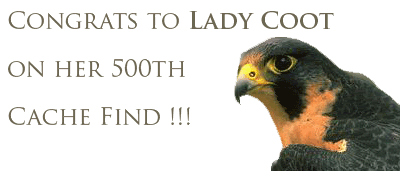
Cache is not at above coordinates. Solve the puzzle to find the
cache.
This cache is to commemorate Lady Coot’s 500th find, and her love
for wild birds.
Original Cache contents:
-Colorado state bird smashed penny (Lark Bunting)
-Stuffed crow toy from Charlotte’s Web
-Idaho State quarters featuring Peregrine Falcons
-Nature poetry book
-Rubber band shaped like a duck
If you could try to keep trading items to a “birds” theme, that
would be great. At the same time, we know like to show up at a
themed cache with items that don’t match the theme, so don’t drive
yourself koo-koo. Peck through until you find a prize you can chirp
about.
These questions are about some birds that are found in Colorado.
The answers are available online with a little online hunting, like
searching for a sentance or two from the question.
Cache location is near parking, and the cache is nested in
natural camo. Please hide well. Parking is at trail head, about 400
feet from the cache, and the walk to the cache is short but scenic.
You will want the Painter's Pause trail.
Match each bird’s habitat with the answer.
The final coordinates are:
39 Degrees 39.ABC
105 Degrees 21.DEF
A : Breeding pairs nest on cliffs and forage over adjacent
coniferous and riparian forests. Migrants and winter residents
occur mostly around reservoirs, rivers, and marshes, but may also
be seen in grasslands, agricultural areas. Uses large cities and
nests on buildings.
B : Boreal and montane coniferous forests, especially mature
forests with abundance of insect-infested snags or dying trees, and
spruce forests.
C : Breeds in a variety of open habitats, including meadows,
grasslands, deserts, parkland, agricultural fields, urban and
suburban areas.
D: Migrants and foraging birds occur over most open habitats
such as grasslands, shrublands and agricultural areas. Its nests
are placed on cliffs. Prefers rangeland and areas of mixed farmland
and forest. Roosts in large trees or on large urban buildings.
E: Most breeding birds are found in ponderosa pine, Douglas-fir,
lodgepole pine, and aspen forests. Some may also occur in riparian
and spruce-fir forests and piņon-juniper woodlands. . Migrants and
winter residents are found in the same habitats as in summer, in
addition to lowland riparian forests and urban areas.
F: Pine forests, especially ponderosa and similar long-needled
pines. Prefers mature pine forests with dead trees and snags.
0. Pygmy Nuthatch
1. Three Toed Woodpecker
2. Canvasback
3. Cooper’s Hawk
4. Turkey Vulture
5. Wilson's Snipe
6. White-throated Swift
7. American Kestrel
8. Peregrine Falcon
9. Yellow-crowned Night-Heron
You can check your answers for this puzzle on
Geochecker.com.
Additional Waypoints
 Birds of a Feather: Lady Coot 500
Birds of a Feather: Lady Coot 500 | Difficulty:
| Difficulty:  | Terrain:
| Terrain: 










 beak.jpg
beak.jpg
 lkw.jpg
lkw.jpg
 p.jpg
p.jpg
 teenage.jpg
teenage.jpg
 TTW.jpg
TTW.jpg

